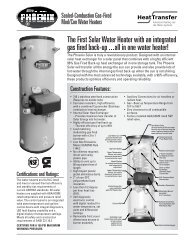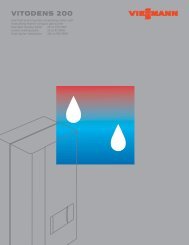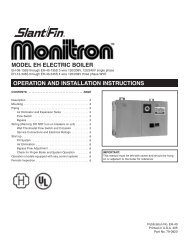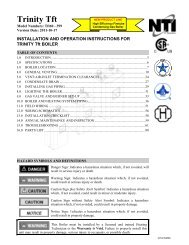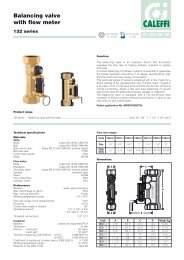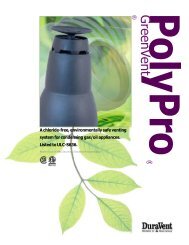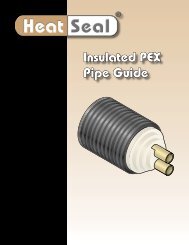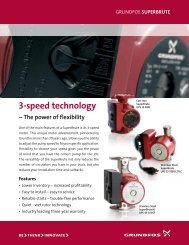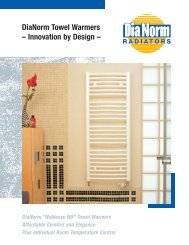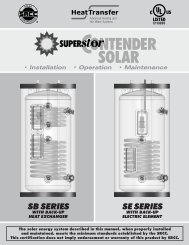Apricus Solar Water Heating System Installation and Operation ...
Apricus Solar Water Heating System Installation and Operation ...
Apricus Solar Water Heating System Installation and Operation ...
Create successful ePaper yourself
Turn your PDF publications into a flip-book with our unique Google optimized e-Paper software.
for space heating. See also 3.6.3 above.3.6.6. Thermal Storage<strong>Apricus</strong> <strong>Solar</strong> Collector <strong>Installation</strong> & <strong>Operation</strong> Manual - USAa) Large Storage Volume: If a large amount of heat is being collected during high solar gain periods, theideal means of preventing system overheating is to have enough thermal storage to store it all. In otherwords: a BIG tank. Instead of having a single 80 gallon tank, multiple tanks connected in parallel/series(ideally using valve logic, heating one tank at a time) or a second, single big tank tank will allow for severaldays worth of heat storage <strong>and</strong> can significantly reduce the need to use auxiliary boosting at night or duringa short period of poor weather, even with a high usage pattern.If such a large tank is not viable from a cost or space perspective, then simply going up one tank size isoften a good option. The difference between an 80 gallon <strong>and</strong> a 120 gallon tank is often not that much interms of the total system cost <strong>and</strong> provides a good amount of extra thermal storage capacity.b) Massive Thermal Storage: It is possible to have a massive thermal store, such as an underground,heavily insulated wet-s<strong>and</strong> tank, which can store huge amounts of excess summer heat for use in the winter(thick polystyrene walls <strong>and</strong> EPDM liner). This is a sort of “thermal battery,” able to store energy for lateruse, <strong>and</strong> if the customer is serious about reducing energy usage in the winter, it is an option worthexploring. Very simply, quality PEX or similar piping can be snaked throughout the wet-s<strong>and</strong> tank to act as aheat exchanger in order to dump excess heat into the thermal store. Incoming cold water can be preheatedas it runs through a separate coil buried in the s<strong>and</strong> <strong>and</strong> extracts heat. There are many designconsiderations, but the basic principle is very simple.Example:An underground, insulted thermal store with a volume of 3530 ft3 (100 m2) filled with 20% water <strong>and</strong>80% s<strong>and</strong> (~2.3 MJ/C*m3) <strong>and</strong> heated to 160°F (70°C) would store about 10.8 million Btus (3163 kWh)of usable heat. This stored heat, used as a pre-heat source to traditional gas/oil boosting for spaceheating <strong>and</strong> hot water, could contribute 70-80% of the energy needed for an average mid-sized housethroughout the winter in a cold region. Installing 90 tubes instead of 30, would achieve this heatstorage during the warmer months.3.7. Multiple Collector Connection3.7.1. Connection of Multiple Collectorsa) Connecting Collectors in Series: <strong>Apricus</strong> has a policy that no more than 150 tubes (5 x AP-30) can beconnected in series <strong>and</strong> recommends a maximum flow-rate of 4 gpm (15 L/min) through any <strong>Apricus</strong>collector. This is for three reasons:i) Excessive high flow rates can “scrub” the walls of the copper header, wearing it away.ii) High flow rates greatly increase the pressure drop, requiring a much larger circulation pump, wastingelectricity.iii) Peak 30 tube collector output is about 6141 Btu/hr (1.8 kW), therefore, the maximum temperaturerise per pass through the collectors will be 15.6°F (8.6°C) at the maximum flow rate specified above. Afaster flow rate provides no major benefit <strong>and</strong> may result in the pump dropping below the pump delta-toff (dTMin) setting <strong>and</strong> causing the pump to cycle ON/OFF.iv) Thermal expansion of more collectors in series could cause buckling of the copper header duringperiods of stagnation.As described earlier in section 3.5, the use of a variable speed pump control is highly recommended. Themaximum flow-rate outlined above should not be exceeded by the pump, even at 100% flow during variablespeed control. For a single collector, reaching flow rates 20-30% in excess of the specified 0.026 gpm/tube(0.1L/tube/min) level is acceptable but, as described above, will reduce the temperature rise <strong>and</strong> potentiallycause pump cycling.! Damage to collectors due to heat expansion <strong>and</strong> copper header distortion is not eligible for warrantyclaims.b) Isolation <strong>and</strong> Drain Valves: Each bank of collectors (up to 5 in series) should have an isolation valve ateach end <strong>and</strong> a drain valve. If the collector bank needs to be isolated for maintenance work the drain valvemust immediately be opened to avoid dangerous pressure <strong>and</strong> temperature buildup.Copyright 2011 – <strong>Apricus</strong> Inc Doc: A7-05.4.1.4-PB-1.9 Page 24 of 126



